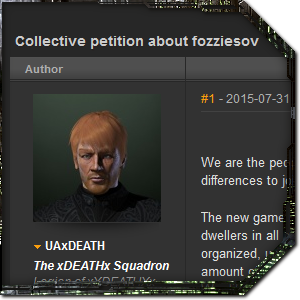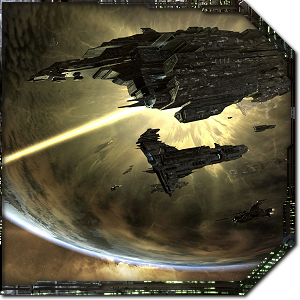
It’s been over a month since EVE Online deployed its new sovereignty and territorial warfare system, and the dust is only now beginning to settle. The Aegis update completely revamped sovereignty warfare, replacing the grind of shooting massive structures with massive fleets with a new system based around the Entosis Link module. It was hoped that the new system would lower the barrier to entry for sovereignty warfare and allow smaller but dedicated alliances to capture and hold space against larger opponents. While the old system made large fleets practically mandatory and led to ever-growing coalitions banding together, it was hoped that the new system would encourage a larger number of smaller fights. When fleets of any size can attempt to contest the ownership of a structure, it’s up to the owners to aggressively defend their space or lose it.
There has been considerable noise in the EVE community since the update went live, with plenty of critical feedback from nullsec alliances and even some backlash directed at its designer CCP Fozzie. Despite complaints, it’s clear that the sov system is achieving some of its stated goals: players have reported an increased number of smaller fights, a few small alliances are capturing space, and industrialists are being actively recruited into nullsec alliances again. The past month of warfare has nonetheless highlighted some pretty serious problems with the sovereignty mechanics that CCP will need to address, some of which it plans to tackle in Tuesday’s Galatea update.
In this edition of EVE Evolved, I delve into the player response to EVE‘s new territorial warfare mechanics, highlight a few remaining problems with the system, and look at the upcoming Galatea sovereignty update.
 Complaints and alliance backlash
Complaints and alliance backlash
The Aegis sovereignty system was the second major part of an initiative to change how nullsec alliances conducted war, the first part being the force projection changes in last year’s Phoebe update. Before these updates, nullsec had devolved into a politically stagnant arrangement with two or three coalitions owning everything between them and absorbing any independent entities who pop up or stomping them into the ground. There was some backlash in response to Phoebe as it limited how far alliances could deploy their capital fleets from their staging systems, and part of the backlash to Aegis feels the same. Both updates took some power and control away from the established nullsec entities and made holding large amounts of empty space more difficult. Aegis in particular makes it easier for renter alliances to break away from their masters, which means less ISK for the landlords. Those affected will naturally make some noise, and it can be difficult to separate that noise from constructive criticism.
The Russian alliances banded together and presented a list of problems they saw with the new system and potential solutions, calling Aegis sovereignty “the greatest discrimination against nullsec dwellers in all of EVE Online history.” After fighting off invaders for a few weeks, they noted that the scope for large scale fights has diminished and that most of their time was spent chasing small gangs and individuals. The Russian coalitions claim a huge sector of space including all of the Rogue Drone regions, and many of those star systems are left vastly underused. As a result, it’s become very easy for small groups to harass the region by trying to capture systems with tiny fleets. More recently, several Russian alliances descended on trade hub system Jita and began suicide ganking players’ freighters while spamming “CCP Fozzie” in local chat in protest.
 Constructive criticism of Aegis sovereignty
Constructive criticism of Aegis sovereignty
Between forum threads and in-depth analyses by EVE blogs and warring alliances, there’s been a great deal of constructive criticism and useful discussion on the state of play and problems that need to be resolved. The sovereignty trolling that players warned about before the patch did end up materialising, with people using cheap destroyers and interceptors to harass unoccupied enemy systems. As a result, the command node capture mechanic that we were very wary of before the patch went live has become an irritating regular cleanup exercise for the defender. There are also far too many capture nodes for each individual structure, and no actual tools to keep track of everything. Alliances are forced to assign someone to keep track of all of the sovereignty timers, and have to respond to every single entosis attack on their space or risk a bout of command node spam to mop up later.
The positive side of all of this is that fights are happening again at a fantastic rate. While Dominion sovereignty encouraged alliances to bring as much force as possible to quickly shoot down structures, Aegis sovereignty is all about bringing the minimum force neccessary to hold the field. There’s a whole strategic element to predicting what kind of force you’ll come up against when capturing something, and many capture events are being invaded by third parties looking for blood. The main point of contention now is that entities can attack sovereignty without committing significant (or sometimes any) forces to actually fight. This has been a long-term problem with Faction Warfare too, which rapidly devolved into people sitting AFK in capture points with disposable frigates rather than actually fighting over them.
 The Galatea patch addresses issues
The Galatea patch addresses issues
In response to the feedback on Aegis sovereignty, CCP has put together a list of balance changes coming in Tuesday’s Galatea update. The number of command nodes that spawn in sovereignty events will be decreased from 20 to 10, and the base capture time will be reduced from 10 minutes to 4 minutes. The defending alliance will also now start with 60% control of the event by default, so if nobody shows up to claim a system then you’ll only need to capture 8 nodes at 4 minutes a piece to clean up the mess. This may give the defender a bit of an advantage in any actual capture event but its main purpose is to make it less irritating to deal with sovereignty trolls who initially try to capture a system and then don’t show up to finish the job.
The patch will also attempt to deal with the problem of uncatchable interceptors being used to troll sovereignty, but it might not be enough. The entosis link will now physically limit a ship’s top speed to 4km/sec, which affects only the misuse case of uncatchable interceptors and doesn’t address the use of disposable entosis ships. The most effective strategy in Aegis sovereignty will always be the one with the lowest perceived risk, so it’s up to the mechanics to force players to commit something worth killing to the fight. Potential solutions include limiting entosis links to cruisers and above or making the entosis ship immobile but remote repairable, but neither of those is on the cards. The outcome desired by many players is that the entosis module should be put on the biggest and tankiest ship you can field, which will be a considerable risk investment and a worthy target for attack. As it stands, the Galatea patch will do nothing to achieve that goal.
 The Aegis sovereignty system has been live now for over a month, and the only thing players seem to agree on is that it needs some balance work. Smaller alliances are finding that they are now a legitimate threat to a larger entity’s sovereignty and can draw out a good fight when they want to, which is a huge victory for the new mechanics. The reality of Aegis sovereignty is also starting to sink in as large alliances are finding that it’s often more trouble than it’s worth to hold onto systems they don’t actively live in. There is probably now more territory out there than the existing playerbase can reasonably defend, and empires may have to shed dead weight systems or fill them up with activity.
The Aegis sovereignty system has been live now for over a month, and the only thing players seem to agree on is that it needs some balance work. Smaller alliances are finding that they are now a legitimate threat to a larger entity’s sovereignty and can draw out a good fight when they want to, which is a huge victory for the new mechanics. The reality of Aegis sovereignty is also starting to sink in as large alliances are finding that it’s often more trouble than it’s worth to hold onto systems they don’t actively live in. There is probably now more territory out there than the existing playerbase can reasonably defend, and empires may have to shed dead weight systems or fill them up with activity.
The system is not without its problems, however, as trolls are able to force the defender to respond to false threats or spend hours cleaning up command nodes. Tuesday’s Galatea patch is simply a small quality of life improvement for those alliances being trolled, and the upcoming Citadel Siege mechanic that lets players set vulnerability windows throughout the week will help a ton, but it’s not going to eliminate trolling. The entosis and control node mechanics need to force the aggressor to actually commit something worth killing to the fight, and I think if CCP can crack that problem then nullsec warfare will be pretty much perfect.
 EVE Online expert Brendan ‘Nyphur’ Drain has been playing EVE for over a decade and writing the regular EVE Evolved column since 2008. The column covers everything from in-depth EVE guides and news breakdowns to game design discussions and opinion pieces. If there’s a topic you’d love to see covered, drop him a comment or send mail to brendan@massivelyop.com!
EVE Online expert Brendan ‘Nyphur’ Drain has been playing EVE for over a decade and writing the regular EVE Evolved column since 2008. The column covers everything from in-depth EVE guides and news breakdowns to game design discussions and opinion pieces. If there’s a topic you’d love to see covered, drop him a comment or send mail to brendan@massivelyop.com!













